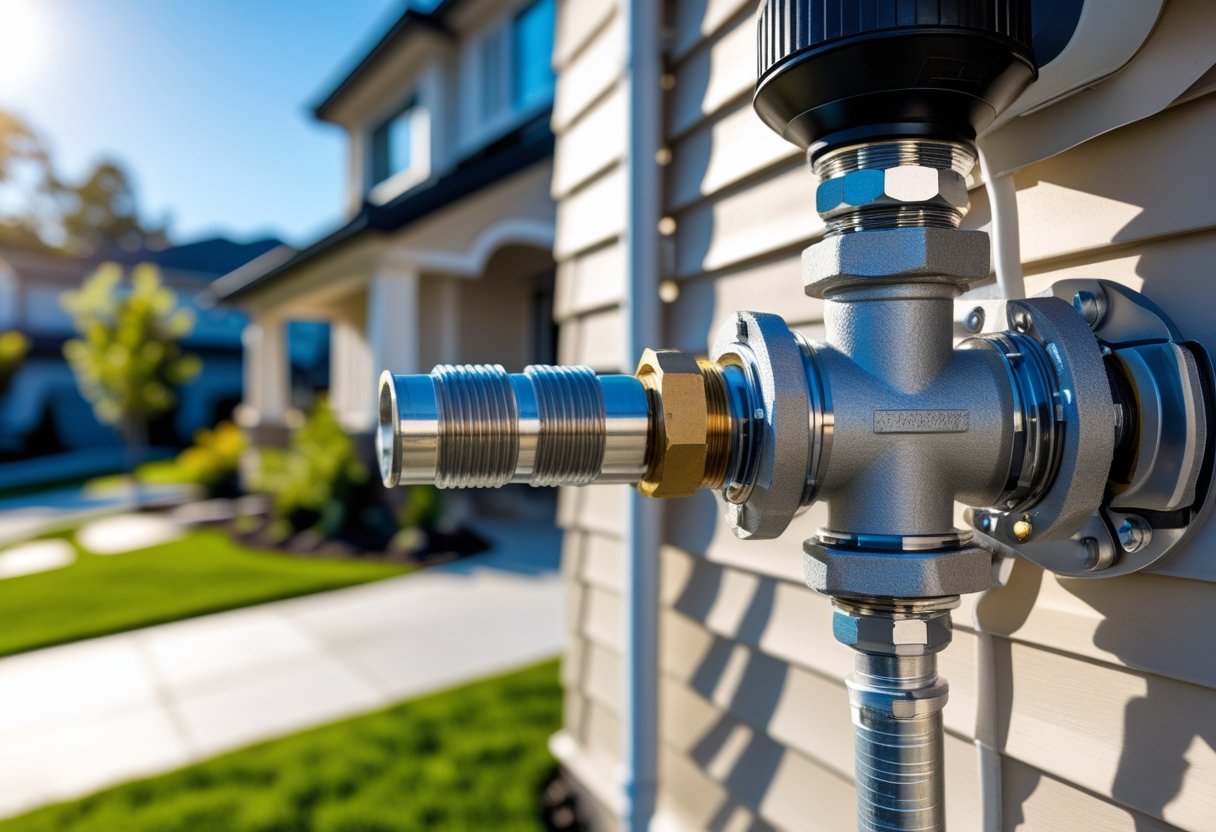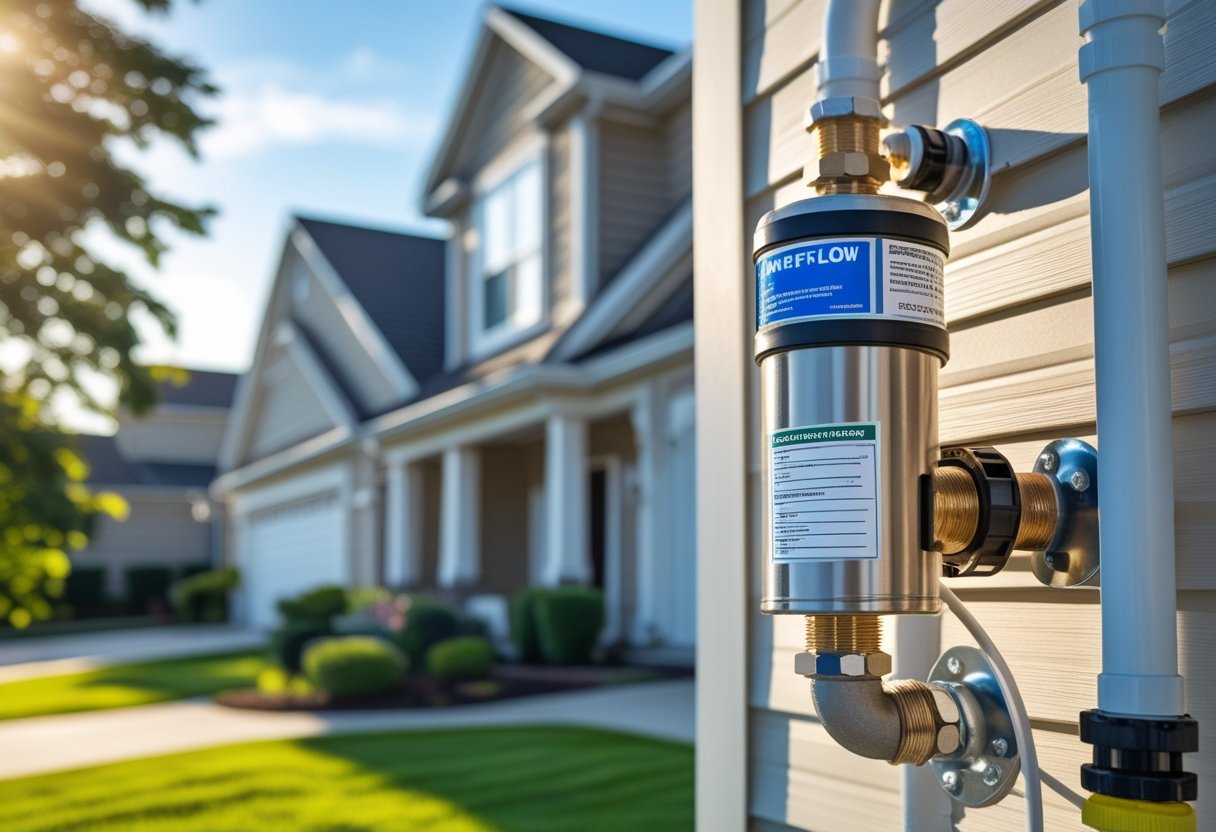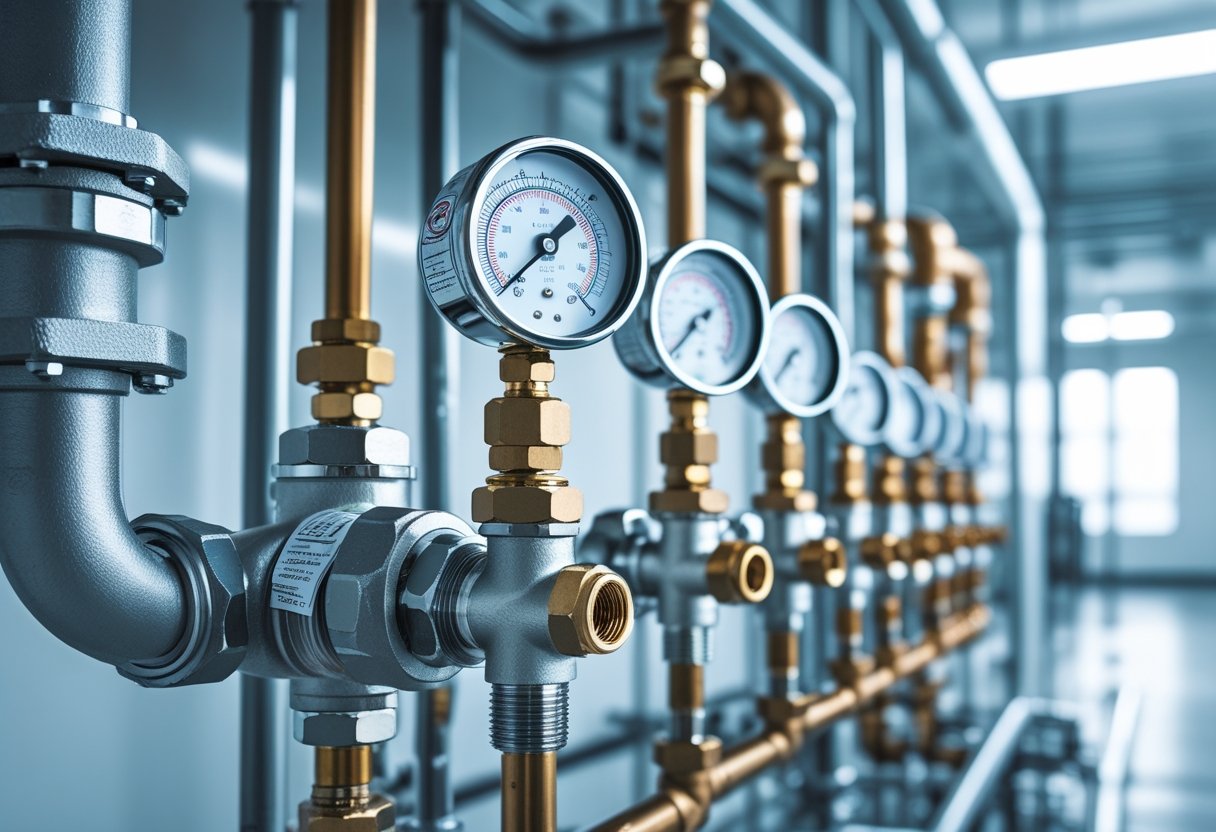Taking care of your backflow device keeps it running longer. Regular maintenance—like annual testing—lets you catch issues early. If you schedule yearly inspections and act on repairs quickly, you’ll stretch the life of your backflow preventer and dodge those big replacement bills.
Protecting your device from damage matters, too. Just insulating it during cold snaps and keeping an eye out for leaks can make a difference. Staying on top of local rules and keeping your device updated helps protect your water supply.
At Pacific Backflow, we get how crucial it is to keep your backflow device in shape. With reliable testing and quick repairs, we help you stay compliant and keep things running smoothly throughout San Diego County.
Understanding Backflow Devices
Backflow devices keep your water clean by stopping contaminated water from sneaking back into your supply. If you know how they work and why they matter, you’ll be better equipped to take care of them—and hopefully avoid some headaches down the road.
What Is a Backflow Device
A backflow device is a plumbing tool that only lets water move one way. It blocks dirty water from making its way back into your clean water lines. You’ll find these in homes, businesses, and irrigation systems—they’re kind of essential for safe drinking water.
Inside, you’ve got check valves, seals, and relief valves. These parts work together to keep things safe. Inspections really help spot trouble before leaks or failures pop up.
Importance of Preventing Backflow
Stopping backflow keeps your water safe. If contaminated water gets into your pipes, it can bring in chemicals, bacteria, or even waste—no thanks. That’s a health risk and, honestly, probably illegal in most places.
By maintaining your backflow device, you keep your water clean and your plumbing in good shape. Most local water districts want annual testing and timely repairs. Getting ahead of problems protects everyone who uses your water.
Common Types of Backflow Preventers
A few backflow preventer types are out there, each with its own job:
- Pressure Vacuum Breaker (PVB): Mostly for irrigation. It stops backflow when pressure drops.
- Double Check Valve Assembly (DCVA): Popular in homes and small businesses. Two valves for double protection.
- Reduced Pressure Zone (RPZ): Top-level protection. Used if there’s a risk of toxins getting in.
Picking the right one depends on your system and local rules. Pacific Backflow can help you sort it out and keep it maintained.
Regular Maintenance Practices
Keeping your backflow preventer in good shape means sticking to some basic routines. Inspections, cleaning, and a bit of lubrication go a long way to keeping things running.
Scheduled Inspections
Have your backflow preventer checked at least once a year. Inspections usually mean looking for leaks, rust, or broken parts. Catching stuff early is a lot cheaper than waiting for a breakdown.
Many places require professional testing, so staying on schedule keeps you out of trouble. Pacific Backflow handles certified inspections and files all the paperwork for you. If something’s wrong, they’ll help you sort it out fast.
Cleaning Procedures
Dirt and debris can mess with your backflow device. Clean the outside and, if you can, flush the inside. Get rid of any gunk around the valves so nothing gets blocked.
Use a mild detergent and water—skip anything harsh that could harm the device. Always shut off the water before you clean to avoid a mess. Not sure what you’re doing? Call a pro for a deep clean.
Component Lubrication
A little lubrication on moving parts keeps your backflow preventer working smoothly. Focus on valve seals and springs, and only use what the manufacturer recommends.
Don’t overdo it—too much lubricant just attracts dirt. Never use oil where water runs. If you keep up with this, seals and moving parts last longer, and you’ll see fewer leaks.
Professional Servicing and Testing
Keeping your backflow device reliable means regular checkups and calling in the experts when it counts. You’ll want to get it tested every year, pick a certified technician, and know what to make of the test results.
Annual Performance Testing
Test your backflow device every year. The test checks if it’s blocking contaminated water like it should. Skipping this can lead to leaks or even water safety risks.
Laws usually require these tests for both homes and businesses. Inspections spot small stuff before it turns into a big repair bill. Plus, annual testing keeps you on the right side of local water rules.
A pro tester uses the right gear and gets accurate results. Afterward, they’ll file a report with your water authority so you’re covered.
Choosing a Certified Technician
You’ll want a certified, experienced technician for your backflow device. Certified testers know your local rules and make sure your device meets all requirements.
Look for someone with good reviews and a track record for solid service. They should know different devices and stick to safety standards.
If repairs come up, a certified pro will recommend fixes that fit your local codes. Getting it done right protects your water and helps your device last.
Pacific Backflow’s techs cover all of San Diego County. They’re quick, dependable, and help you stay compliant without the headache.
Interpreting Test Results
When your device gets tested, the results show if it’s working or not. Pass? You’re good. Fail? You might need repairs or a replacement.
The test report has details like pressure and valve function—handy for troubleshooting. Your tech should walk you through what the numbers mean, no jargon.
See a problem? Get it fixed soon. Ignoring issues can lead to bigger trouble or fines.
Keeping clear records helps you plan future maintenance and makes inspections easier. Plus, it just feels good to know your system’s safe.
Early Detection of Issues
Watching your backflow device helps you spot trouble before it gets expensive. Knowing the warning signs and acting fast can save you money and protect your water. Leaks, corrosion, and other red flags are worth learning to recognize.
Recognizing Warning Signs
Keep an eye (and ear) out for weird stuff—strange noises, low water pressure, or water that looks off near the device. Those can mean valve trouble or debris.
Failing a backflow test? That’s a big warning sign. If tests keep failing or problems keep coming back, something inside is probably worn out.
Jot these things down and check your device regularly. The sooner you notice, the easier the fix.
Responding to Leaks
Leaks around your backflow preventer are bad news. Even a little drip can mean valves are shot and dirty water might get in.
If you see a leak, turn off the water if you can. Then call a pro right away. Quick repairs stop bigger damage and keep your water clean.
Don’t let leaks slide—they can get expensive fast. Check for leaks often, especially after heavy use or storms.
Addressing Corrosion
Corrosion eats away at your backflow preventer and cuts its life short. Look for rust or mineral buildup, especially on metal parts.
If you find corrosion, gently clean it with a wire brush or a cloth soaked in vinegar. Avoid harsh stuff that can make it worse.
You might want to add a protective coating or paint made for plumbing fixtures. Putting your device in a dry, well-ventilated spot helps, too.
Stay on top of maintenance and tackle corrosion early. If it’s already bad, Pacific Backflow’s team can help with repairs or inspections.
Protecting Your Backflow Device
If you want your backflow device to last, you’ve got to shield it from cold snaps, physical knocks, and tampering. Weatherproofing, damage prevention, and a bit of security go a long way.
Weatherproofing and Insulation
Freezing weather can wreck backflow devices—ice can bust valves and seals, leading to leaks or worse. Use insulation like foam covers or heat tape (made for plumbing).
Wrap your device well and seal up any gaps where cold air sneaks in. If your device drains water, keep that drain clear so it doesn’t freeze. Sometimes, a small outdoor heater nearby helps if freezing is a regular headache.
Check insulation now and then. If it’s cracked or soggy, swap it out. Good weatherproofing can save you a lot of hassle in winter.
Preventing Physical Damage
Backflow devices often sit outside, so they’re easy targets for lawnmowers, cars, or falling branches. Put a sturdy barrier around yours—a fence, frame, or guard rail that doesn’t block maintenance.
Keep the area clear of junk or stuff that could fall on it. Don’t store heavy tools nearby. Physical hits can cause leaks or mess with how well it works.
If your device is near a driveway, try bright paint or reflective tape on the barrier so folks spot it and steer clear.
Vandalism Deterrents
Sadly, backflow devices sometimes get vandalized or stolen, especially in out-of-the-way spots. A metal cage custom-fit for your device keeps it safe but still easy to access for maintenance.
Go with cages that lock using tamper-resistant hardware. Adding lights or cameras nearby can also scare off troublemakers.
Label your backflow device so folks know it’s important and monitored. Pair security with regular checks. That way, you lower the risk of theft or damage and keep your water supply safe.
If you want help with security features or regular testing, Pacific Backflow covers San Diego County with reliable service to keep your device secure and compliant.
Proper Installation and Upgrades
Making your backflow device last starts with getting it installed right and swapping out parts when they’re worn. Picking the best spot, sizing it correctly, and changing old parts all help you avoid headaches and keep your water safe.
Selecting the Right Location
Choose a spot that’s easy to reach for testing and repairs. Avoid places that flood or get blasted by weather—those can cut your device’s life short. If you can see and get to your backflow preventer easily, you’ll save time and money later.
Follow local codes and skip spots with chemicals or heavy foot traffic. If you can, put it near a drain to handle leaks. Not sure where to put it? Pacific Backflow can suggest the best placement for your system in San Diego County.
Ensuring Correct Sizing
Your device needs to fit your water system’s size and pressure. Too small? It could fail under heavy use. Too big? You’re wasting space and money. Check with your water district or ask a pro to measure what you need.
Getting the size right helps your device work efficiently and last longer. If you’re not sure, ask the experts at Pacific Backflow—they can help you avoid expensive mistakes. Sizing matters if you want to keep your water safe and your system running smoothly.
Replacing Aged Parts
Old parts just don’t last forever—they wear down and can start leaking or fail outright. Keep an eye out for worn valves, cracked seals, or any rust showing up. Regular checks and some quick tests usually catch these things before they turn into headaches.
When you spot something worn out, go ahead and swap it for a new one. That way, you’re not letting a tiny issue snowball into a big mess that could threaten your water. It’s worth using good parts when you upgrade—cheap ones just don’t hold up. Getting a pro to test your system every year? That’s a smart move; they’ll often spot what needs replacing before you even notice a problem.
Optimizing Water Quality
If you want your backflow device to last and keep your water clean, you’ve got to watch details like pressure and sediment. These little things really do matter.
Managing Water Pressure
Too much or too little pressure messes with your backflow device. High pressure strains the parts inside, which leads to leaks or early breakdowns. When pressure drops too low, the device can’t really do its job to keep dirty water out.
Pressure regulators or gauges help keep things steady. Check them now and then—don’t just set and forget. If you start hearing weird noises or that banging sound (water hammer), it’s time to call someone who knows their stuff. Keeping pressure in the right range goes a long way toward making your device last and keeping your water safe.
Reducing Sediment Buildup
Sediment and junk building up inside your backflow preventer can slow it down or make it fail. Problems with water quality often start when dirt collects inside. You can cut down on sediment by using filters in your plumbing—catch the gunk before it gets to your device.
It’s a good idea to schedule cleanings or at least inspections, just to catch any buildup early. Flushing your pipes sometimes helps clear things out, too. All this cleaning keeps your water supply safer and helps your device do its job for the long haul.
If you’re in San Diego County and want expert help, Pacific Backflow offers reliable testing and maintenance. They’ll help you keep your water safe and your system running longer.
Staying Informed and Compliant
Knowing the rules and keeping your paperwork in order both matter more than most people think. These habits keep your system safe, working right, and out of trouble with the city.
Understanding Local Regulations
Your backflow device has to meet local requirements, especially around San Diego County. Most water districts want yearly tests to make sure your device is doing its job and the water stays clean. California’s got its own laws, like Title 17, setting the standards.
You’ll need to know when your tests are due and what inspectors look for. If your device doesn’t pass, you might have to repair or replace it. Following these rules keeps your property safer and helps you avoid fines.
If you’re not sure about the details, Pacific Backflow can handle inspections, repairs, and even file the reports for you. Keeping up with local rules really does help your backflow device last longer.
Keeping Maintenance Records
Good records make life easier. Hold onto every test result, repair note, and replacement receipt—stash them somewhere safe.
Looking back at these records helps you spot patterns, like which parts wear out first, so you can get ahead of problems. That way, you can plan maintenance or replacements before things get serious.
Detailed logs also prove you’ve followed the rules if anyone asks. Pacific Backflow can give you copies of their work whenever they test or fix your device.
Try organizing your records by date and what was done. It’s simple, but it’ll save you time and hassle when you need to show you’re compliant.
Frequently Asked Questions
Keeping your backflow device in good shape isn’t rocket science—it’s about regular checks, routine maintenance, and knowing when to swap out worn parts. Understanding these steps helps you avoid leaks and expensive repairs down the line.
What maintenance steps can prolong the life of my backflow preventer?
Get your backflow preventer inspected and tested every year—don’t skip it. Clear away any debris, and check for leaks or damage whenever you think of it. Flushing your system now and then helps get rid of sediments that wear things out.
Are there specific environmental factors that affect the durability of a backflow device?
Absolutely. Extreme cold—especially freezing—can crack parts. Hard water or high mineral content leads to buildup inside. And if your device is out in the open, physical damage or vandalism can shorten its life.
What are the best practices for testing your backflow system regularly?
Book annual testing with a certified tech. They’ll make sure your device is working right and you’re following local rules. Keep all your test and repair records, so you’ve got a clear picture of your device’s history.
How often should components of a backflow preventer be replaced to ensure its longevity?
Some parts might need swapping every few years, depending on how much use they get. Full replacement usually makes sense every 5 to 10 years. If you notice leaks, cracks, or failed tests, don’t wait—replace those parts sooner.
Can professional installation and servicing impact the lifespan of backflow prevention devices?
Definitely. When pros install and service your device, it meets codes and works the way it should. They’ll catch trouble early and fix it before it turns into something big.
Is there a difference in lifespan between various types of backflow preventers?
Backflow devices can last anywhere from 5 to 15 years, give or take, depending on their design and how you use them. Some models just seem to handle high pressure and tough conditions a bit better, especially if you stay on top of maintenance.
If you're in San Diego County and need reliable testing or service, Pacific Backflow offers expert care to help keep your system safe and running smoothly.











